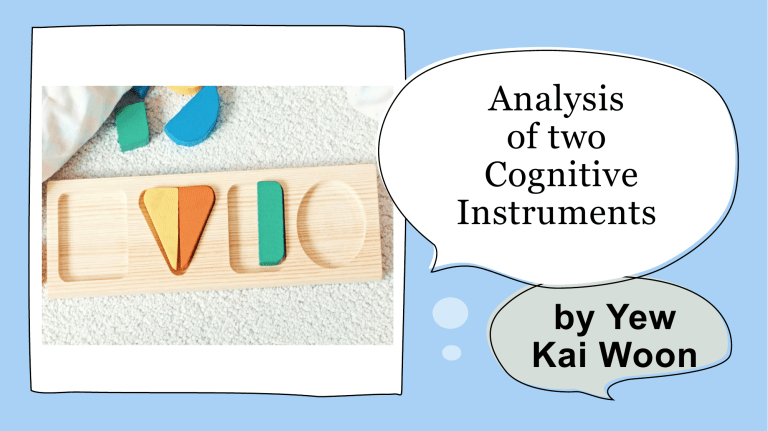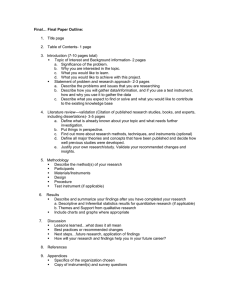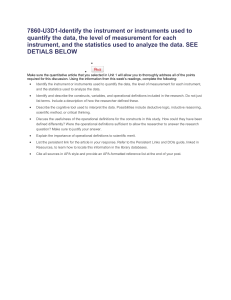
Analysis of two Cognitive Instruments by Yew Kai Woon instruments o Instrument is a tool that is used to collect data to measure variables in skills, abilities, and knowledge of children within a specific age range. o Various types of instruments include checklists, achievement/aptitude tests, observation forms, performance assessment, and so on. o Cognitive instruments: measure an individual’s attainment in academic areas (e.g., reasoning, perception, memory, verbal and mathematical ability, and problem-solving). This PPT will highlight 2 cognitive instruments used by the kindergartens and describe the range of the instruments used to collect child outcome data and evaluate the initiatives, summarizing information of the instruments used. The two main elements that account for the quality of an instrument are its reliability and validity. quality of an instrumen t Reliability • Reliability is the degree to which the instrument consistently measures what it suppose to measure. • For example, a test is said to be reliable if repeat measurement made by it under constant conditions will give the same result. Validity • Validity is the degree to which the instrument accurately measures what it intends to measure. • For example, a test of school readiness can be examined to see whether the content relates to knowledge and skills expected of first-grade children following the kindergarten program. >> Creative Curriculum Developmental Continuum for Ages 3–5 [ Observation Form ] https://wvde.state.wv.us pdfosp/CreativeCurricul umContinuum.pdf Analysi This observation record is an authentic assessment s records children’s in which a teacher/ observer activities in their regular classroom setting and then records the results, in the form of a rating scale. The target age range of this instrument was designed to collect data from a narrow age span— preschool age 3-5 years old children. This instrument stated the time to administer is depending on ongoing teacher observations and it is recommended that the observer goes for training through the publisher. This instrument reported internal consistency reliability coefficients of 90. It also reported evidence from factor analyses to support the validity of the instruments. Learning and Problem solving: 1 Observes objects and events with curiosity 2 Approaches problem flexibly 3 Show persistence in approaching tasks 4 Explores cause and effect 5 Applies knowledge or experience to a new situation Logical Thinking: 1 Classifies objects 2 Compares/ measures 3 Arranges objects in series 4 Recognizes patterns and can repeat them 5 Show awareness of time and space concepts and sequence 6 Show awareness of position in space 7 Uses one to one correspondence 8 Uses numbers and counting Representation and Symbolic thinking: 1 Take on pretend roles 2 Makes believe with objects 3 Makes and interprets representations coverage area for cognitive development Creative Curriculum Developmental Continuum for Ages 3–5 >> Development Checklist from CDC [ Checklist ] https://www.cdc.gov/ ncbddd/actearly/pdf/ checklists/Checklists -with-Tips_Reader2019_508.pdf Analysi This checklist is a screening instrument that requires a s teacher/parent who is familiar with the child to indicate how well a child can do specific tasks or knows certain content. The target age range of this instrument was designed for 2 months infants - 5 years old toddlers. The average time to administer this instrument is about 10-30 minutes. The conductor is ideally someone knowledgeable in child development. No information on reliability and validity was available. coverage area for cognitive Development development Checklist from CDC Learning and Problem solving: 1 Express emotions (happy, sad, fussy, bored) 2 Responds to affection 3 Recognizes people and things 4 Observes objects and events with curiosity 5 Explores things in different ways 6 Finds hidden things 7 Copies gestures 8 Follows instructions 9 Scribbles or draw 10 Builds towers or blocks 11 Names items and use things correctly 12 Can work toys with buttons, levers, and moving parts 13 Does puzzles 14 Screws and unscrews jar lids or turn the door handle Logical Thinking: 1 Sort shapes and colors 2 Compares 3 Completes sentences 4 Uses numbers and counting 5 Show awareness of time and sequence 6 Recognizes patterns and can repeat them 7 Uses one to one correspondence Representation and Symbolic thinking: 1 Take on pretend roles 2 Makes believe with objects 3 Plays board or card games Overview of 2 Instruments No. Name of instrument Purpose Age range Domains assessed Type of administration Time to administer Reliability/ validity data 1 Creative Curriculum Developmental Continuum for Ages 3–5 Tracking child outcomes, Curriculum planning 3 – 5 years Cognitive development, Language development, Social/emotional development, Physical development Observation record Summarized periodically High degree 2 Development Checklist from CDC Screening 2 months infant – 5 years Cognitive development, Language development, Social/emotional development, Movement/Physical development Direct child assessment; Teacher observation; Parent Interviews 10-30 minutes No information Overall, an observational measure often collects more authentic data related to children’s performance and it has a proven track record (adequate reliability and validity). However, it may be more time-consuming, and the conductors need to go for certain training to conduct the assessment as there is continual interaction with student work such as observing, questioning, and guiding. A checklist is less expensive and easy to use because the conductors require little instruction or training. However. It does not include the quality of performance on the objectives measured. And, the interaction between the child and the person who completes the instrument must be considered. The result can be affected by the length of time the person has known the child, and their abilities to collect data. They also typically have different levels of information about a child in different situations and settings. Compari son For the cognitive development part, a checklist focuses on overall proficiency at each level, while an observational measure provides a more constructive approach with performance-based. No. Name of instrument Price 1 Creative Curriculum Developmental Continuum for Ages 3–5 2 Development Checklist from CDC Comparison of 2 Instruments Strong points Time consuming Role of teacher/ conductor Measurement Result Reliability/ validity data More expensive Collects more authentic data Long period of time Require training and need continual interaction with student work More constructive approach with performancebased High degree Cheaper, can easy found online Flexible and easy to use 10-30 minutes No training required Overall proficiency at each level No information There is no perfect instrument, instead, the main consideration for choosing an instrument is the assessment objective. The teacher or parent should review the items of the instrument and agree on what each is intended to measure. Conclusion Thank you by Yew Kai Woon





